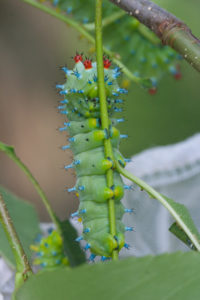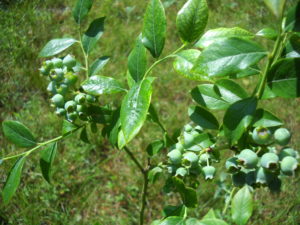Trees and Shrubs Are Important for Pollinators
When I say “Pollinator”, you think bee, right? Honeybee, bumblebee, wild bee. But what about moth, butterfly, beetle or fly? Many of those are pollinators, too. I recently read an interesting article about pollinators by Dan Jaffe and Jane Roy Brown in the “Native Plant News,” a magazine put out by the New England Wild Flower Society.
The authors’ basic premise is that moths and butterflies are the unsung heroes of pollination, and important part of a balanced ecosystem. Of the 700 or so species of butterflies and moth (Lepidopterans) found east of the Mississippi, 500 species are supported by five native trees: oaks, cherries, willows, birch and poplar or aspen. In comparison, our perennial flower bee balm (which is loved by bees) supports just 11 species of butterflies and moths.
I called Dan Jaffe and asked this: what is the value of Lepidopterans to the average gardener? Can’t bees take care of our fruit trees and veggies? Yes, he said, bees are great pollinators, but butterflies and moths feed our baby birds – and birds are great at controlling insect pests and moving seeds around the landscape to create a biologically diverse environment.
It works like this, he said. Baby birds need a high protein diet, so parent birds serve them caterpillars as 95% of their diet, even birds that are seed eaters as adults. If there are no caterpillars, fewer baby birds will survive. And, he noted, our native species of trees are much better at feeding them than introduced decorative species.
Many butterflies and moths depend on specific species of plants to survive. Most of us know about monarch butterflies: they only will lay their eggs on milkweed. As adults, however, the monarchs will feed on many flowers including asters, goldenrod and a variety of other flowers. The endangered Karner blue butterfly depends on sundial lupine (Lupinus perennis) – and will not even feed on other related lupines. Planting to support specific butterflies is a worthy endeavor.
Dan Jaffe emphasized to me that planting native species is important: they are trees and shrubs that evolved with our butterflies and moths, so that is what they are programmed to find and eat. Native trees and shrubs provide the leaves needed to feed caterpillars and to make their chrysalises. Pollinators need not just pollen, but food and habitat throughout their life cycles.
According to the article by Jaffe and Brown, willows are “the unsung heroes of the lepidopteran world.” The native black willow (Salix nigra) supports over 400 different species of butterflies and moths. I planted one 25 years ago near my brook and it is now a full-sized tree, perhaps 35 feet tall and 25 feet wide. Early on I kept it pruned as a shrub, but I skipped pruning for a couple of years – and it became a tree!
I also grow three kinds of pussy willows, including our native one, Salix discolor, which grows wild along my stream. I also grow rosemary willow, a curly willow, and a variegated-leafed, non-native willow (Salix integra ‘Hakuru nashiki’). All of those have stayed under 20 feet tall and thrive in the sunny moist area near my stream.
All my willows are fast growing and some will spread by root, although the rosemary willow (Salix elaegnos) has not spread. The rosemary willow has leaves that look almost identical to rosemary leaves. I have to admit that, until now, I had never thought of willows as food for caterpillars or adult butterflies.
Also mentioned in that article are the cherries. They support some 400 species of butterflies and moths. I have a huge black cherry (Prunus serotina) growing next to my house and overhanging my deck. It was there as a large tree when I bought my house 49 years ago, and is huge now – 60 feet tall or more, and the trunk is 4 to 6 feet in diameter at its base. I see lots of caterpillars on it each summer, and butterflies around it. Still, it is a messy tree dropping berries, leaves and twigs. I wish it were elsewhere on the property, but I won’t cut it down.
Choke cherry (Prunus virginiana) is common in disturbed areas as a shrubby volunteer growing in full sun and poor soil. It is often a multi-stemmed shrub that blooms in May or June with small white flowers followed by red berries in July and August. Again, it supports pollinators with nectar, pollen, and leaves to munch on – and birds like the berries, too.
One last plant to consider for pollinators and birds is the ordinary blueberry. It has lovely flowers in June, berries we all like later, and colorful leaves in fall. So what if the birds get most of the berries? Consider it your part of supporting a diverse and healthy ecosystem – including some 294 species of butterflies and moths.
To learn more about native plants, visit the Garden in the Woods in Framingham, MA next spring, where you can buy native plants. Visit their web site now, http://www.newenglandwild.org, for more information.
Henry can be reached by e-mail at henry.homeyer@comcast.net. He is a lifetime Master Gardener and the author of 4 gardening books. He lives and gardens in Cornish Flat, NH.





